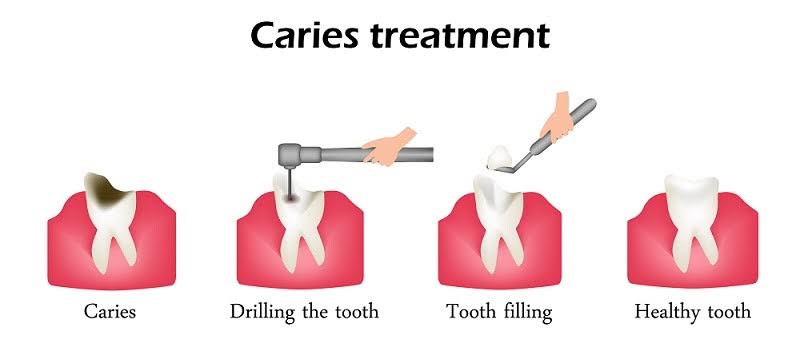Dental Filling Types and Procedure in Thane
A small cavity development on teeth keeps spreading over the teeth over a period if not treated early. A dental filling is one of the better solutions for this. Here, the cavity development on teeth is cleaned and filled with proper dental fillings for preventing it from more damage and cavity build-up. In Thane, you can get quality dental filling treatment.

Talk to a Dentist Now!
Dental Filling
A cavity is like an obstruction, an obstacle, a huge hurdle in the normal and basic functioning of a tooth. The removal of this cavity is necessary to save the remaining teeth and its attached parts such as the root, the gums, and the entire jaw structure. But removal of that cavity will leave an empty, hollow space which can then be seen as an opportunity by the bacteria to create a home inside it. Hence, to prevent such a scenario from taking place, the dentist does what is needed, that is, places a dental filling in this gap from the removal of a cavity. This dental filling serves as a base and as a layer of protection for the tooth. Sabka Dentist in Thane provides the best dentists to fill up the hollow and vacant spaces with high accuracy.
When is it necessary to get a dental filling?
Identifying the need for a dental filling begins with identifying the presence of a cavity or any other infection in the tooth. We, at Sabka Dentist, Thane, help you understand our methods of diagnosing a filling :
- Observation : Medical practitioners have the ability to sometimes identify and catch a problem by seeing through their eyes. Similarly, dentists can sometimes notice the discoloration on an individual’s tooth or teeth, which signifies as a sign of decay of the tooth. A dental instrument known as Explorer is used to detect cavities by using varying levels of pressure. If the tooth enamel gives in to the pressure extended by the Explorer, then this serves as evidence for the presence of a cavity. Howsoever, if the tooth enamel can resist the pressure exerted by the Explorer, then this will indicate that there are no cavities and that the tooth and the enamel is healthy.
- Cavity detecting dye : The dye is poured into your mouth and it will make the infected areas stand out by highlighting them.
- X-rays : The simplest yet most effective way is by getting an X-ray removed. Sabka Dentist yet again changes the dental game here by providing the best consultation along with a dental check up and x-ray and absolutely no cost.
- Laser fluorescence device : The infection, decay and caries in the tooth are detected by this device. A green color on the device will indicate healthy tooth enamel, whereas the red and yellow color will indicate the decayed and infected areas of the tooth.
What are the other reasons for the need of a filling?
- Cracked or chipped or fractured teeth
- Misuse of teeth while opening things with your teeth
- Misuse of teeth while biting your nails
- Tooth grinding

Steps involved in a dental filling
- Using the above mentioned methods, such as observation, cavity detecting dye, x-ray and laser fluorescence devices, the dentist will try to search for any existing cavity or a potential one, so as to avoid it from spreading, beforehand.
- Local anesthesia is then administered into the area of the decayed tooth, so as to relieve the patient from pain for sometime.
- Dental equipments that are handy like the drill are used to eliminate the decayed section of the tooth. The dentist moves from a high level of speed to extract the decayed part and then shifts to a low level of speed so that it touches and comes in contact with the deltin, also known as the second layer of the tooth.
- Once the decayed element is entirely extracted from the tooth, the space is then used to create an impression of the filling that is to be placed.
- Since the pulp of the tooth is also exposed to all of this during the process, it is lined with a base or a liner to protect itself from any kind of infection.
- In the special case of a bonded filling, the dentist prepares the tooth beforehand by the application of acid gel. Bonded fillings are more reliable as they eliminate the risk of the infection reaching below the filling.
- A special light is used to toughen the filling and make it resistant and reliable.
- Using burs, the tooth is then polished by the dentist.
Post a dental filling
There is a slight sense of displeasure after getting a dental filling. Eating sweets, hot, cold food will not be the same, as there is a new member that is still being adjusted along with your other set of teeth. Sometimes, the sensitivity is so severe that the dentist might have to check and change the material of the filling, that is, either a composite resin, gold, porcelain or amalgam. And if the level of sensitivity only worsens, then the filling needs to be checked thoroughly by the dentist, with attention to detail.
Whatever the dental issue may be, it needs to be explained well to the concerned dentist. Either a root canal treatment may be suggested owing to the filling being penetrated deep into the gum of the tooth or a desensitizing agent may be utilized to reduce the level of sensitivity.
As soon as the anesthesia finishes its job, the patient might feel some discomfort and pain every time they chew or bite their food. While the sudden shock that takes place when the patients’ teeth clench together, is known as galvanic shock. It is like a wave of electricity or current passing through your mouth. These are the two main kinds of pain that are felt as soon as you get a dental filling. There are several instances wherein the edges of the dental cap or crown, are not buffed properly, easily inviting these shocks and discomfort in the patient’s mouth. But of course, the only time it is felt is when the anesthesia is no longer acting in the injected area.
Temporary filling
There is no specific difference between a temporary and permanent filling other than
Its longevity. A temporary filling is one that protects your teeth and helps it from getting damaged further. An ingredient known as Eugenol is used to relieve the patient of a toothache that he or she may fact post the extraction of decaying material. However a temporary filling is given only in a few exceptional cases, post which, it is necessary to get a permanent filling.
You may receive a temporary filling (usually white, off-white or gray) if:
- Your treatment requires more than one session.
- Your dentist wants to wait a short period of time for the tooth to heal.
- You have a deep cavity and the pulp (containing the nerve and blood vessels) becomes exposed during treatment.
- You need emergency dental treatment.
Replacement of a dental filling
Falling out, leaking or discoloration of a filling calls for its replacement. Over time, some things wear out. Dental fillings are no different. They lose their original color and become discolored which looks unpleasant. Cracks and leaks are caused due to the varying levels of pressures applied by us while chewing or eating food. Hence, all these reasons suffice for the replacement of dental fillings. There have also been an instance where the food creeps in and starts building up below the filling. This gets us back to the start of the cycle wherein the food gets stuck, forms a layer, attracting bacteria, and hence causing decay of the tooth. Therefore, regular checkups and changes of dental fillings have now become a compulsion for an individual.
Why fillings fall out
- The varying level of pressures can be resisted by our strong teeth, but the weak teeth and teeth containing dental fillings, cannot withstand the pressure, which causes the food and bacteria to seep in and cause an infection. This makes the already existing filling weak, and hence it cannot stay together any more, which causes it to fall apart.
- Not everyone is as precise as Sabka Dentist. Hence, before putting the filling, it may get contaminated or infected, which causes it to wear our right from the beginning.
- Leakage occurs when the filling and tooth don’t fit together perfectly like a missing piece in a puzzle. In such cases, the gap, if any, even the smallest, can cause a leak and allow the food to form a layer, causing an infection all over again.
- Clenching and grinding are habits that you will need to get rid of in case you have dental fillings inserted in your mouth. They exert forces like never before, causing the dental fillings to crack or leak.
- There is a limited time period for each dental filling, 15 years being the average and maximum time period that a dental filling stays fresh. Hence, they fall apart once they cross their time period.
Additional help is required for the maintenance of dental fillings. For instance, fluoride toothpaste is recommended by the dentist, along with brushing your teeth twice a day and flossing at least once a day. Fluoride will help in strengthening your teeth, while also improving the health of your enamel.
About Author

Dr. Jena after graduating as a Dental Surgeon in 2007 she started working under a well known private practitioner as an associate Dentist. After one and a half years of experience in private clinic she joined a reputed trust Total Dental Care in january 2010 and continues her work with us till the time it got converted into a large dental chain SABKA DENTIST.
Dr.Jena is associated with SABKADENTIST from the time of its inception. Initially she worked as an associate Dentist and was promoted to the post of Dental Director in August 2011. Initially she was given a responsibility of handling many operations of the clinic. Her hard work paid off when she was ultimately given the charge of Audit and Compliance of all clinics of SABKADENTIST across 5 cities. Her solitary goal is to put the company on the peak through stringent Audit and Compliance.



